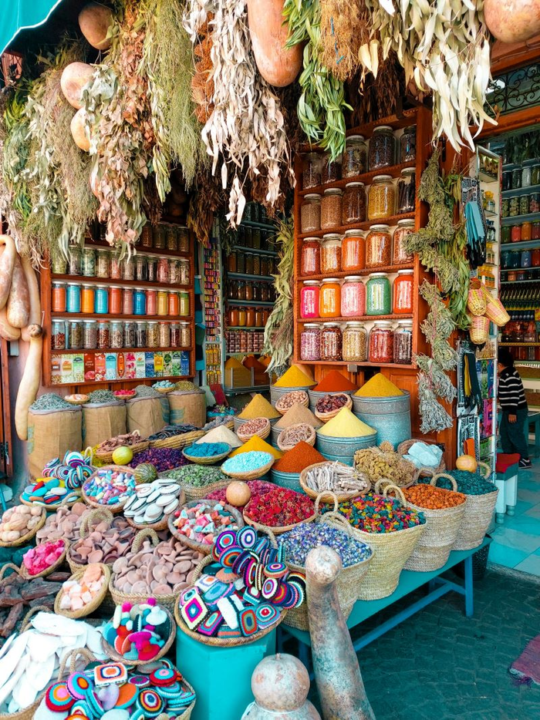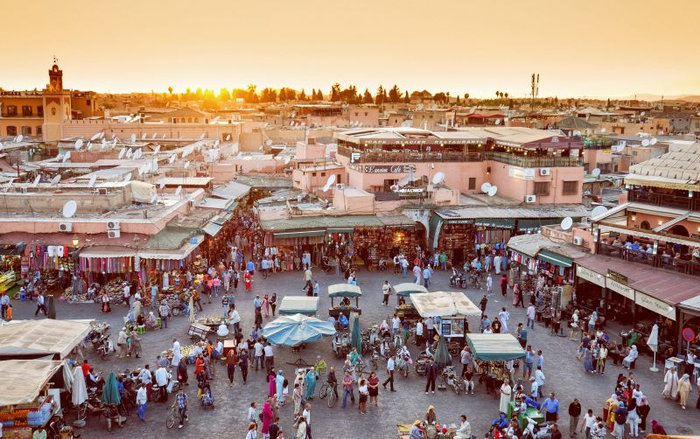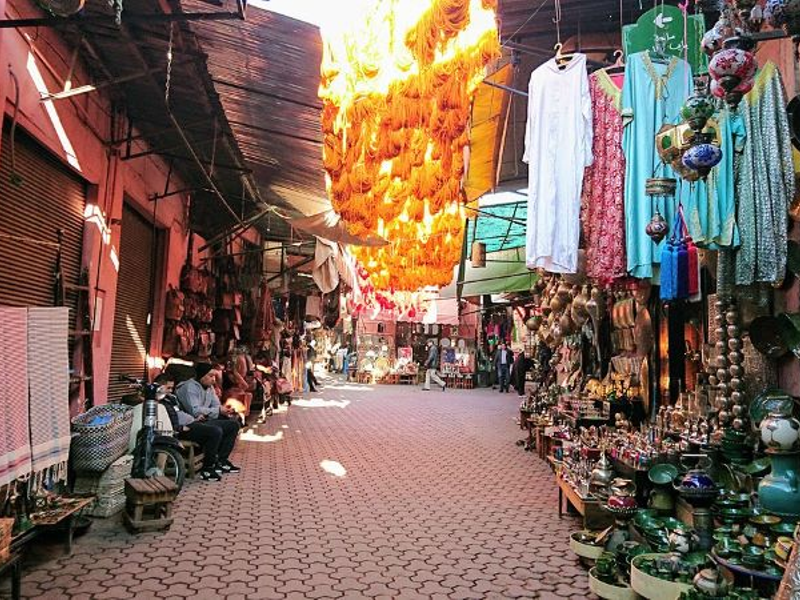mage: Street of Marrakech. Source: Wikimedia Commons
Marrakech, the “Red City” of Morocco, pulsates with life, fueled by its ancient tradition of market culture. Stepping into the labyrinthine medina, one is transported to a sensory feast – sights of colorful textiles and gleaming spices, bartering merchants and rhythmic music, and aromas of sizzling tagines and sweet pastries. These souks, or marketplaces, are more than just places of commerce; they are the city’s beating heart, weaving together history, craftsmanship, and community. They offer a glimpse into the soul of Marrakech, profoundly shaping the lives of local artisans and businesses.
A Journey Through Time and Tradition:
The souks of Marrakech have existed for centuries, their layout unchanged, echoing the architectural heritage of the medieval city. Each souk specializes in a particular trade, creating distinct and immersive experiences. In the Cherratin, leather workers transform hides into intricately tooled bags and poufs. Artisans in Nejjarine mesmerize with their delicate woodwork, from ornate furniture to intricate chessboards. The air in Souk el Attarine hangs heavy with the aroma of spices – saffron, paprika, and cumin, conjuring visions of Berber kitchens and bustling caravans.
Artisanship: Keeping Traditions Alive:
Marrakech’s souks are a haven for traditional artisans, preserving centuries-old skills passed down through generations. Master weavers sit at looms, creating vibrant carpets with intricate knotwork, while potters shape the region’s red clay into graceful tagines and teapots. Metalworkers hammer out lanterns and jewelry, their rhythmic clanging echoing through the narrow alleys. These artisans are not just preserving history but infusing it with contemporary styles and innovations, adapting to the evolving tastes of tourists and locals alike.

Photo by zakariae daoui on Unsplash
The Business of Bustle:
Beyond crafts, the souks are a vibrant hub for small businesses. Family-run stalls overflowing with dates, olives, and fresh produce paint a picture of local agriculture. Tailors take measurements and sew custom djellabas, catering to the unique styles of Marrakech. Berber women sell hand-painted ceramics and embroidered slippers, adding a touch of personal charm to the commercial landscape. These businesses, though small, provide vital income and contribute to the city’s economic ecosystem.
Impact on Artisans and Businesses:
The market culture has a profound impact on the lives of those involved. For artisans, it offers a platform to showcase their skills and earn a living. However, challenges exist. Fluctuations in tourism can affect income, and competition can be fierce. Organizations like cooperatives and training programs play a crucial role in this environment, providing artisans better access to markets, resources, and fair pricing.
Similarly, for businesses, the souks can be a double-edged sword. While foot traffic is high, navigating regulations and competing with larger retailers can be difficult. Initiatives like rent subsidies and marketing support can help small businesses thrive in this competitive environment.
Challenges and Opportunities:
The future of Marrakech’s market culture is not without its challenges. Globalization and changing consumer preferences can pressure artisans to compromise on tradition. Additionally, concerns about fair trade practices and the exploitation of artisans need to be addressed. Embracing sustainable practices, empowering artisans through education and reasonable pricing, and promoting responsible tourism is crucial to ensure the market culture thrives for future generations.

Photo by CALIN STAN on Unsplash
Beyond Commerce: A Cultural Tapestry:
Ultimately, the markets of Marrakech are more than just places of economic exchange. They are vibrant social spaces where community thrives. Merchants weave stories into their sales pitches, inviting laughter and bargaining banter. Women gather over steaming glasses of mint tea, sharing gossip and news. This social interaction strengthens the fabric of the community, fostering a sense of belonging and cultural identity.
Conclusion:
The vibrant market culture of Marrakech is not just a tourist attraction but a testament to the city’s rich history, craftsmanship, and community spirit. As visitors navigate the labyrinthine alleys, they become part of a living tradition, supporting local artisans and businesses while immersing themselves in the unique cultural tapestry of the Red City. By understanding the challenges and opportunities faced by those within the souks, we can contribute to their continued success, ensuring that this enchanting labyrinth continues to pulsate with life for generations to come.

Anand Subramanian is a freelance photographer and content writer based out of Tamil Nadu, India. Having a background in Engineering always made him curious about life on the other side of the spectrum. He leapt forward towards the Photography life and never looked back. Specializing in Documentary and Portrait photography gave him an up-close and personal view into the complexities of human beings and those experiences helped him branch out from visual to words. Today he is mentoring passionate photographers and writing about the different dimensions of the art world.





